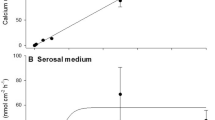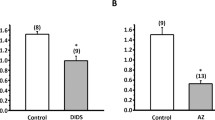Abstract
The skin of intact, free-swimming Xenopus laevis transports Ca2+ inwardly in a manner that is proportional to the external [Ca2+] up to about 0.3 mmol · l−1, saturates above 0.3 mmol · l−1, and is opposed to the electrochemical gradient. Efflux is relatively constant at external concentrations between 0.016 and 0.6 mmol · l−1; net flux which is negative below 0.125 mmol · l−1 becomes positive above this external [Ca2+]. Allometric analysis suggests that both Ca2+ influx and efflux scale to the 2/3 power approximately like surface area. There were no significant differences in influx between summer and fall animals; however, efflux was greater in the fall and this resulted in a change from positive balance in the summer to negative balance in the fall. Isolated skins were shown to support a Ca2+ uptake rate of nearly 30 nmol · cm−2 · h−1. The phenylalkylamine verapamil in the apical bathing solution significantly inhibited this at 25 μmol · l−1. The benzothiazepine diltiazem was also effective at 50 μmol · l−1 while the dihydropyradine nifedipine was ineffective up to 100 μmol · l−1. The inorganic ion La3+ was effective at blocking Ca2+ uptake at 300 μmol · l−1; Ni2+ was also effective at 500 μmol · l−1 but Co2+ was ineffective up to 500 μmol · l−1. These results suggest that apical calcium channels in Xenopuslaevis skin have properties similar to mammalian L-channels and fish gill Ca2+ channels.
Similar content being viewed by others
Author information
Authors and Affiliations
Additional information
Accepted: 23 January 1997
Rights and permissions
About this article
Cite this article
Guirguis, S., Yee, J. & Stiffler, D. Active calcium ion transport in Xenopuslaevis skin. J Comp Physiol B 167, 328–334 (1997). https://doi.org/10.1007/s003600050081
Issue Date:
DOI: https://doi.org/10.1007/s003600050081




